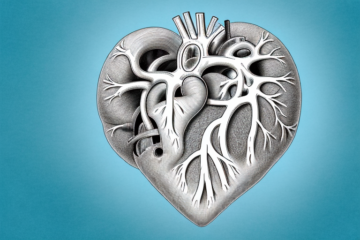Congenital Bilateral Absence of the Vas Deferens (CBAVD) is a genetic condition characterized by the absence of both vas deferens tubes, which are responsible for carrying sperm from the testes to the urethra during ejaculation. This condition was first recognized in the mid-20th century and is associated with a higher risk of infertility in men. In this article, we will discuss the symptoms, causes, diagnosis, and treatment options of CBAVD.
What is Congenital Bilateral Absence of the Vas Deferens?
Congenital Bilateral Absence of the Vas Deferens is a genetic condition that affects the reproductive system of men. It is usually diagnosed when a man tries to conceive and is unable to do so. CBAVD is not a life-threatening condition, but it can cause infertility in men who have it.
CBAVD is caused by a mutation in the CFTR gene, which is responsible for producing a protein that regulates the movement of salt and water in and out of cells. This mutation leads to the absence of the vas deferens, which is the tube that carries sperm from the testes to the urethra. Men with CBAVD still produce sperm, but they are unable to ejaculate them during sexual intercourse.
There is currently no cure for CBAVD, but there are treatments available to help men with the condition conceive. These include surgical procedures to retrieve sperm from the testes, and assisted reproductive technologies such as in vitro fertilization (IVF) and intracytoplasmic sperm injection (ICSI). It is important for men with CBAVD to seek medical advice if they are experiencing infertility, as early diagnosis and treatment can improve their chances of fathering a child.
Understanding the Male Reproductive System
The male reproductive system consists of the testes, epididymis, vas deferens, seminal vesicles, ejaculatory ducts, prostate gland, urethra, and penis. The testes produce and store sperm, which are transported through the epididymis and vas deferens to the seminal vesicles and prostate gland. The seminal vesicles and prostate gland produce semen, which is ejaculated through the urethra during sexual intercourse. In men with CBAVD, the vas deferens tubes are missing, which makes it impossible for sperm to travel from the testes to the urethra.
The male reproductive system is regulated by hormones, including testosterone, luteinizing hormone, and follicle-stimulating hormone. These hormones are produced by the pituitary gland and the testes, and they play a crucial role in the development and function of the male reproductive system. Testosterone is responsible for the development of male secondary sexual characteristics, such as facial hair, deep voice, and muscle mass.
Various factors can affect male reproductive health, including age, lifestyle, and medical conditions. Aging can lead to a decline in testosterone levels, which can affect sperm production and sexual function. Lifestyle factors, such as smoking, alcohol consumption, and drug use, can also have a negative impact on male reproductive health. Medical conditions, such as diabetes, hypertension, and obesity, can increase the risk of erectile dysfunction and infertility.
What Causes Congenital Bilateral Absence of the Vas Deferens?
Congenital Bilateral Absence of the Vas Deferens is a genetic condition that is caused by mutations in the CFTR gene. This gene provides instructions for making a protein called the cystic fibrosis transmembrane conductance regulator. Mutations in this gene can lead to the development of cystic fibrosis in some individuals and CBAVD in others.
Research has shown that individuals with CBAVD have a higher risk of carrying mutations in the CFTR gene, even if they do not have cystic fibrosis. This is because the mutations that cause CBAVD are often different from those that cause cystic fibrosis. In some cases, individuals with CBAVD may not even know they carry a CFTR mutation until they try to conceive a child and are diagnosed with infertility. Genetic counseling and testing can help identify carriers of CFTR mutations and inform family planning decisions.
Signs and Symptoms of Congenital Bilateral Absence of the Vas Deferens
Most men with CBAVD have no symptoms and do not realize that they have the condition until they try to conceive and find out that they are infertile. However, some men may experience other symptoms, such as recurrent respiratory infections, digestive problems, and a salty taste on their skin.
Research has shown that CBAVD is often associated with cystic fibrosis, a genetic disorder that affects the lungs, pancreas, and other organs. Therefore, individuals with CBAVD may also experience symptoms related to cystic fibrosis, such as chronic cough, wheezing, and difficulty breathing.
In addition, some studies have suggested a possible link between CBAVD and an increased risk of testicular cancer. Men with CBAVD may want to discuss this potential risk with their healthcare provider and consider regular testicular exams as a precautionary measure.
Diagnosis and Testing for Congenital Bilateral Absence of the Vas Deferens
If a man suspects that he has CBAVD due to infertility, he should seek medical evaluation from a urologist or infertility specialist. Diagnosis of CBAVD is made through a combination of physical examination, genetic testing, and imaging studies, such as ultrasound or magnetic resonance imaging (MRI).
During the physical examination, the doctor will check for the presence of the vas deferens, which is the tube that carries sperm from the testicles to the urethra. If the vas deferens is not palpable, genetic testing may be ordered to confirm the diagnosis of CBAVD. This testing can identify mutations in the cystic fibrosis transmembrane conductance regulator (CFTR) gene, which is responsible for the production of the vas deferens.
Imaging studies, such as ultrasound or MRI, may also be used to visualize the reproductive organs and confirm the absence of the vas deferens. In some cases, a biopsy of the testicular tissue may be necessary to determine if sperm are present and can be used for assisted reproductive techniques, such as in vitro fertilization (IVF) or intracytoplasmic sperm injection (ICSI).
Treatment Options for Congenital Bilateral Absence of the Vas Deferens
There is currently no cure for CBAVD, but there are several treatment options available to help men with the condition to conceive. These include surgical interventions, such as vasoepididymostomy or testicular sperm extraction, and assisted reproductive technologies, such as in vitro fertilization or intracytoplasmic sperm injection.
It is important to note that not all treatment options may be suitable for every individual with CBAVD. Factors such as age, overall health, and the severity of the condition may impact the effectiveness of certain treatments. It is recommended that individuals with CBAVD consult with a healthcare professional to determine the best course of action for their specific situation.
Surgical Intervention for Congenital Bilateral Absence of the Vas Deferens
Surgical interventions may be recommended for men with CBAVD who want to conceive naturally. Vasoepididymostomy involves connecting the vas deferens directly to the epididymis to bypass the blockage caused by CBAVD. Testicular sperm extraction involves retrieving sperm directly from the testes using a small needle or biopsy procedure. Both of these procedures are complex and should be performed by experienced urologists or infertility specialists.
It is important to note that surgical intervention may not always be successful in achieving natural conception for men with CBAVD. In some cases, assisted reproductive technologies such as in vitro fertilization (IVF) may be necessary to achieve pregnancy. IVF involves fertilizing an egg with sperm outside of the body and then transferring the resulting embryo to the uterus.
It is also important for men with CBAVD to undergo genetic testing and counseling, as this condition can be associated with cystic fibrosis. Genetic testing can determine if a man is a carrier of the cystic fibrosis gene, and counseling can help individuals and couples understand the implications of this information for their future family planning.
Assisted Reproductive Technologies for Men with Congenital Bilateral Absence of the Vas Deferens
Assisted reproductive technologies (ART) are non-surgical options that can help men with CBAVD to conceive. These include in vitro fertilization (IVF) and intracytoplasmic sperm injection (ICSI). IVF involves fertilizing eggs with sperm outside the body and implanting the resulting embryos into the female partner’s uterus. ICSI is a similar procedure, but involves injecting a single sperm directly into an egg.
It is important to note that while ART can be effective for men with CBAVD, it is not always a guarantee of success. Factors such as the quality and quantity of sperm produced, as well as the age and fertility of the female partner, can all impact the success rates of these procedures. Additionally, ART can be expensive and may not be covered by insurance, making it important for couples to carefully consider their options and potential outcomes before pursuing these treatments.
Lifestyle Modifications to Manage Congenital Bilateral Absence of the Vas Deferens
Men with CBAVD can minimize their risk of complications by making certain lifestyle modifications. This may include maintaining a healthy weight, avoiding smoking and excessive alcohol consumption, and seeking prompt treatment for any respiratory or digestive symptoms.
Additionally, regular exercise can also be beneficial for men with CBAVD. Exercise can help improve overall health and reduce the risk of respiratory and cardiovascular complications. It is important to consult with a healthcare provider before starting any new exercise regimen.
Prognosis and Outlook for Congenital Bilateral Absence of the Vas Deferens
Men with CBAVD can expect to have a normal lifespan and experience the same health risks as the general population. However, infertility can be a significant source of stress and emotional distress for affected individuals and their partners.
It is important for individuals with CBAVD to seek medical advice and counseling regarding their infertility. There are various options available for assisted reproduction, such as in vitro fertilization (IVF) and intracytoplasmic sperm injection (ICSI), which can help couples conceive.
In addition, individuals with CBAVD may also benefit from genetic counseling, as the condition can be associated with other genetic disorders such as cystic fibrosis. Genetic testing can help identify any potential risks for future children and allow for informed family planning decisions.
Coping Strategies for Men Living with Congenital Bilateral Absence of the Vas Deferens
Men with CBAVD who are experiencing infertility may benefit from counseling or support groups. This can help them to cope with the emotional impact of the condition and explore their options for starting a family. Genetic counseling may also be recommended for affected individuals and their partners to assess the risk of passing on the condition to their children.
In conclusion, Congenital Bilateral Absence of the Vas Deferens is a genetic condition that affects the male reproductive system and can cause infertility. It is caused by mutations in the CFTR gene and can be diagnosed through a combination of physical examination, genetic testing, and imaging studies. While there is no cure for CBAVD, men with the condition have several treatment options available to help them conceive. If you think you may have CBAVD, seek medical evaluation from a qualified healthcare professional.
Living with CBAVD can be challenging, both physically and emotionally. Men with the condition may experience feelings of isolation, frustration, and sadness. It is important for them to find healthy coping strategies to manage these emotions. This may include talking to a therapist, joining a support group, or engaging in activities that bring them joy and fulfillment. It is also important for men with CBAVD to communicate openly with their partners about their fertility challenges and work together to explore their options for starting a family.










